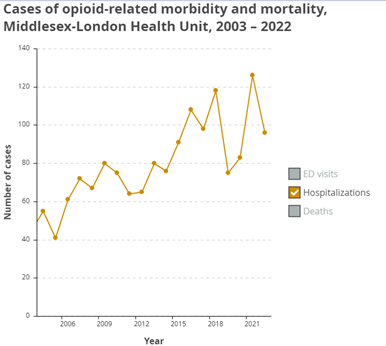Needle Recovery
Middlesex-London currently has up to 28 access points, including a mobile unit, satellite locations, pharmacies, a large fixed site at Regional HIV/AIDS Connection, and a site at MLHU’s CitiPlaza location. Additionally, there are 23 public needle disposal bins, and the City of London offers 24/7 needle pick-up through its Dispatch service. In 2022, 1.7 million syringes were distributed across these access points.
- Free and confidential needle exchange services are available at Regional HIV/AIDS Connection (RHAC), the Middlesex-London Health Unit and My Sister’s Place.
- Well-marked stationary needle disposal bins in several public areas collect discarded needles and syringes; they also assist with overall recovery of used injection drug equipment. See the list of stationary needle disposal bin locations and learn more about the safe handling and disposal of needles.
If needles are found on public property:
If needles are found on public property, please call 519-661-2489 ext. 4965. This phone line is answered 24 hours per day, 7 days per week.
Public drug use
People tend to use drugs in public areas, because they don’t otherwise have a safe location to do so. This public drug use can lead to unsafe consumption practices, which increase the risk of overdose and the spread of diseases, such as hepatitis C and HIV. In addition, discarded equipment, such as used needles, pose a potential risk of injury for those who use public spaces where people inject drugs.
.png)

![[Graph] Rates of invasive Group A Streptococcal (iGAS) infections in Middlesex-London and Ontario [Graph] Rates of invasive Group A Streptococcal (iGAS) infections in Middlesex-London and Ontario](/uploads/img/2019-02-05-invasive-group-a-streptococcal-infections-in-middlesex-london-and-ontario-web-small.gif)
![[Graph] Reported rate of new HIV infections in Middlesex-London and Ontario [Graph] Reported rate of new HIV infections in Middlesex-London and Ontario](/uploads/img/2019-02-05-new-hiv-infections-in-middlesex-london-and-ontario-web-small.gif)
![[Graph] Reported rate of new Hepatitis C infections in Middlesex-London and Ontario [Graph] Reported rate of new Hepatitis C infections in Middlesex-London and Ontario](/uploads/img/2019-02-05-new-hepatitis-c-infections-in-middlesex-london-and-ontario-web-small.gif)
![[Graph] Count of Injection Drug Use Associated Endocarditis [Graph] Count of Injection Drug Use Associated Endocarditis](/uploads/img/count-of-injection-drug-use-associated-endocarditis-web.jpg)